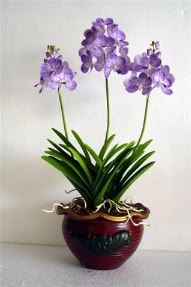 There are three common types of orchid pots. They include plastic, terracotta, and basket. The best type of pot for you depends on the potting mix, type of orchid, and location that you're growing the plant. You may also want to consider how often you will need to repot the orchid. Let's take a look at the three main types oforchid pots.
There are three common types of orchid pots. They include plastic, terracotta, and basket. The best type of pot for you depends on the potting mix, type of orchid, and location that you're growing the plant. You may also want to consider how often you will need to repot the orchid. Let's take a look at the three main types oforchid pots.Plastic
One of the most common types of orchid pots is the plastic variety. Plastic pots have the advantage of being lightweight. Clear plastic is popular as it allows you to keep an eye on the roots to make sure pests and diseases aren't damaging them. Plasticorchid pots also retain water longer than clay pots.
It's usually best to use these pots indoors since the wind can easily blow them over if they're used outside. Also if you use plastic orchid pots outside, they will eventually be damaged by UV light. If you do want a plastic design for use outside, you should at least make sure it has a light color. Therefore, it won't heat up as much in the sun.
Terracotta
Terracotta or clay orchid pots are also common. These designs are much heavier than their plastic cousins. However, the added weight gives them more stability to withstand strong winds. As mentioned earlier, terracottaorchid pots lose water faster than plastic pots. Most designs only have one drainage hole located in the bottom, but some special designs also have drainage holes located on the sides.
Basket
One of the last common types of orchid pots is the basket design. These pots are best suited for sprawling plants with pendant flowers. The basket designs are usually constructed of wood, mesh, wire, or plastic. The advantage of basketorchid pots is that they allow air to circulate better than any other type. A disadvantage of basket designs is that the potting mix will dry out quickly. You will also need to place blocks in theseorchid pots to support the plant.
Now that you know something about the common types of pots, why not stop by care4orchids.com to learn about caring for orchids. Learn how to take proper care of orchids so that you can grow the most beautiful flowers. Stop by today!
by . D.Swain


